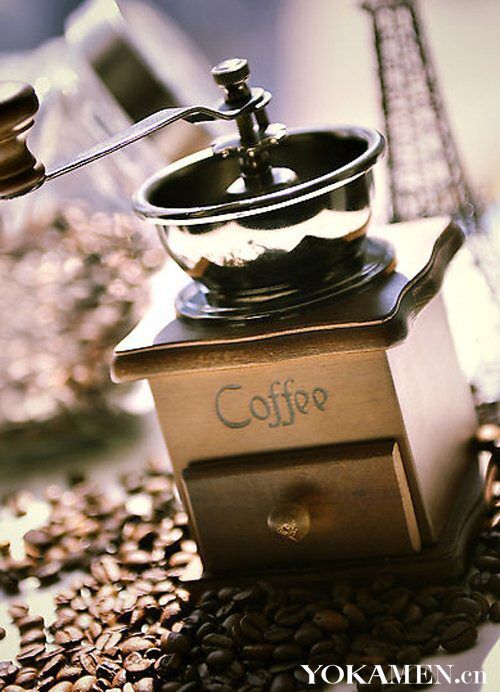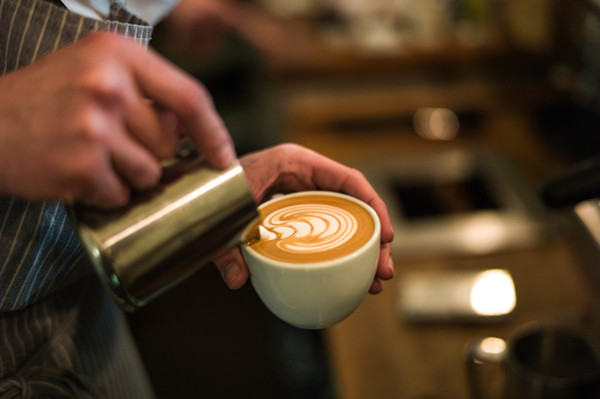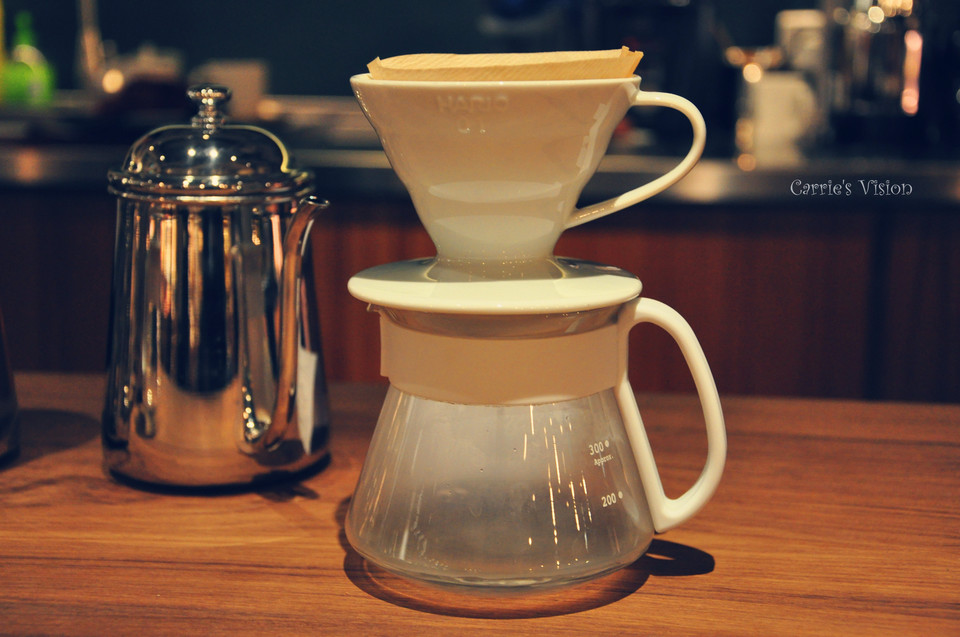Importance of Grinding degree of Coffee beans and Coffee Powder thickness of Coffee Powder Grinding
There are many ways to extract coffee, and the various appliances we use for extraction also have different grades. Many beginners like to spend most of their equipment budget on high-end coffee pots (such as siphons, French presses, hand brewers and filter cups), and even on expensive hario hand brewers. And grind beans machine to buy a very cheap hand mill or copy electric mill, chop beans machine to wait casually however. However, taking the most popular hand-washing extraction method as an example, the general price of more than 100 or even dozens of hand-washing pots can also obtain more stable and finer water flow through training (even some of them are very easy to use), the filter cups are not inferior to glass or copper filter cups, and the sharing pot is more casual. Then he began to constantly study the coordination of various data of brewing methods, grinding scale, water temperature, how to stew, how to control water injection, water powder ratio, extraction time. The above is important, but many people ignore the grinding quality of the grinder is that we can not control it through practice, and even take it for granted that the extra money paid for buying the grinder is not proportional to the improvement of coffee and insist on using an extremely low-end grinder. However, they do not know that the grinding quality of coffee beans is the most important thing in the final cup of coffee. So I suggest: "play coffee again poor can not poor grinder, rich do not have to rich coffee pot." I even saw a newly opened coffee shop with kalita 900ml copper pot, with chemex and kone metal filter, hario electronic scale with timing function, bean grinder unexpectedly hario mss-1b, I said I suggested he change the mill, open a shop with a small Fuji is not too much! The boss replied,"I don't think it's necessary, this mill is very useful, what is small Fuji?" Never heard of it." He was speechless. This is a real story. I have encountered similar situations more than once or twice.
Yerga Sherfi is a coffee that most coffee lovers like. I have been indulging in sunbathing yeja for the past year. Recently, I suddenly found that I haven't drunk water washing yeja for a long time. So I put in some Kocher washed G2, and immediately after baking, I made a cup (the bean grinder equipped with the baking department is a large Pegasus 207n). I went down in one bite and felt that it was a touching taste. It was amazing. It was rare for the G2 to have such a performance. Back at home in the evening, full of anticipation after dinner and make a cup, the effect has become mediocre (the residence with the bean grinder is Solis166). Before this, I couldn't figure out why freshly baked beans tasted so good, but after a night, or even a few hours, when I went home and tried again, the taste was completely different. (Often because time is tight, baking is completed and rushed home with beans to try, the big Pegasus only occasionally has enough time to test beans after baking.) After this huge difference in taste, I decided to make an official comparison. (It was also clear before that the bean grinder had a big impact on the production, but never experienced such a huge gap).
This experiment only compares with the bean grinder I have in my hand, which are respectively:1. Taiwan Yangjia Pegasus 207n (ghost tooth), 2. Solis166(cone knife), 3. mazzer superjolly(flat knife) may not be suitable, but it is here anyway, no matter whether I use it or not, so I still send it as the flat knife representative! (It should be noted that these three grinders are not intended to represent three types of grinding machines, but desperate choices.)
First of all, the three grinders are adjusted to a relatively close grinding scale.
In order to avoid all kinds of unstable factors in the brewing process as much as possible, this comparison instrument selects Philharmonic pressure.
Brewing method:
Coffee powder: 15 g
Water temperature: 88 degrees
Water injection: try to control the injection of 250ml hot water in 1 minute
Press: Try to control the coffee to the sharing pot in 45 seconds
With details such as screwing the cap and reversing the Philharmonic pressure, the whole extraction process is controlled in about 2 minutes.
In order to flavor more complete and more prominent, to facilitate my limited level of tasting, this test coffee beans selected Yejia Shefei washed Kocher G1
Comparison results:
1. Yang Family Pegasus 207n(Ghost Teeth)
Aromatic fragrance on the palate, moderate acidity and soft comfort
The middle part is extremely sweet, with a clear sweet taste of ripe fruit (plum? Melon? Probably so, specific can not be described, my taste level is limited)
The tail part is slightly sour, and the acid has a honey-like sweet taste.
The overall taste is round and smooth, and the sweet feeling in the mouth will not dissipate for a long time after drinking.
If you want to make a metaphor for flavor intensity, you should know more about Sunlight Aricha. The flavor prominence of this washed Kocher G1 is very close to that of fruit bombs like Aricha.(Of course, the flavor is different, but the flavor prominence reaches a similar level)
2, Solis166(cone cutter)
The aroma of the flowers at the entrance is weak and the acidity is weak.
Importance of coffee beans and coffee powder grinding (coffee powder grinding thickness) coffee powder thickness
The sweetness in the middle is still high, but it loses the sweet fragrance in 207n, and the aroma of ripe fruit becomes faint.
The tail section is no honey sweet feeling, and finally there is a astringent feeling.
The overall taste is relatively thin compared to 207n products.
3, mazzer super jolly(flat knife)
The floral fragrance almost disappears at the entrance, and the acidity is the most obvious of the three mills, but this acid appears to be relatively stiff.
The sweetness of the middle part is less affected by acidity, the fruit aroma is weak, and there is a certain degree of bitterness.
The sweet taste of the tail segment disappeared quickly, but there was no astringency.
The overall taste is also relatively thin.
In the end, I think the rankings are as follows:
1. Yang Family Pegasus 207n(Ghost Teeth)
2, Solis166(cone cutter)
3, mazzer super jolly(flat knife)
After this comparison, I definitely want to start small Fuji. In the past two or three years of real contact with coffee, because of the small size and moderate price of the bean grinder, perhaps I have missed a lot of delicious food,(of course, not to say that only the ghost tooth mill can have a good product, but at least to know the importance of the bean grinder to a cup of coffee) Whether it is a single product or Italian, to make a good cup of coffee, the importance of the bean grinder is far greater than the brewing appliance itself. I hope that friends who have read this article, if conditions permit, do not miss the delicious food that should belong to you. The last sentence is still the same sentence: "No matter how poor you are, you can't be poor in the bean grinder. No matter how rich you are, you don't have to be rich in the coffee pot."
Note: This article is just a personal whim, please forgive all kinds of unprofessional comments and idiotic comparison methods.
The importance of coffee beans and coffee powder grinding (coffee powder grinding thickness) coffee powder thickness
I want to answer some questions from my friends.
First, the relationship between grinding thickness and extraction time
Coffee grinding is about fine, the more dense the powder layer, the more coffee powder particles contact with hot water, the extraction resistance increases, the extraction time is easier to extend, and the extraction rate is increased, and it is easy to extract too much.
On the contrary, the coarser the touch, the larger the powder layer gap, the less coffee powder and water contact, the weaker the extraction resistance, the lower the extraction time, the lower the extraction rate, so it is easy to extract insufficient.
Therefore, the veteran will control the extraction time according to the powder thickness. Fine powder, then slightly shorten the extraction time. The extraction time was slightly prolonged.
Second, the deep-baked beans are slightly thicker, and the light-baked beans are slightly thinner.
In addition, before determining the grinding degree of coffee beans, the veteran will first judge the color and oil extraction of the cooked beans. The lighter the roasting, the harder it is to extract, and then use a slightly fine grinding. The deeper the baking, the easier it is to extract, then use a slightly coarse grinding.
Therefore, deep shallow fine. (However, it should not be too coarse or too fine, which will cause abnormal extraction and affect coffee flavor)
Third, the grinding degree of various brewing methods, from coarse to fine, is:
French filter press (thick)
Electric drip pot (medium thick)
Hand rinse pot, siphon pot, desktop smart filter cup (medium)
Mocha pot (medium thin)
Espresso (fine)
Turkish coffee (very fine)
Two things must be corrected!
1, the amount of extracted substances, not because of the resistance caused by the size of the powder layer, if it is really because of the coarse grinding resistance is small, then do Italian, relative to light pressure fine grinding, with coarse grinding pressure, why can you achieve consistent flow rate? Do not simply think twice that the pressure powder for people can resist 9 bar pressure, if it is really a person may use the pressure powder force to resist 9 bar pressure, think about how the coarse grinding pressure flow rate is too fast.
The difference in flavor between fine and coarse grinding can be seen in Dr. illy and some coffee masters who mention that coffee extraction only extracts the surface of the powder ball.
2, the soluble substances extracted are related to the thickness, but the extraction rate is not absolutely equivalent to this, otherwise why do many competitors reduce the extraction rate by increasing the amount of powder through relatively coarse grinding and slightly finer grinding?
For the relationship between extraction rate and concentration, it is recommended to look at relevant articles, such as Zhe's copy.
Siphon coffee to do the use of coffee powder fineness, to be thicker than espresso, hand rub up, should have a little granular feeling. If you use a professional electric grinder, the effect is of course the best, you can simply and quickly use different scales of coffee powder to try to compare, to find the most suitable brewing method, coffee varieties have thickness.
There is a grinder on the market that costs about 200 yuan and the motor blades are violently broken. In the past, there were some multifunctional juicers with more than 100 pieces, and there were similar functional components. This so-called grinder grinds unevenly, not "grinding" but "beating." Get out of the powder is very uneven, sell more expensive, try not to use. Especially siphoning coffee.
When making siphon coffee, use the hand-operated bean grinder, which is more emotional and can also meet the demand. Adjust the thickness before use, and control the fineness of coffee outflow by adjusting the gap between the rotor and the powder. If the beans fall too fast or do not change for a long time, they need to be adjusted. After boiling water, start grinding, so that the water in the siphon coffee pot can be ground before boiling, so that the coffee powder emits aromatic substances in the air for the shortest time, the most able to maintain the original taste of coffee.
Siphon coffee focuses on flavor. Therefore, the grinding speed should not be too fast, too fast and easy to overheat, overheating will accelerate the volatilization of coffee powder aroma; it should not be too slow, coffee powder exposed to the air for a long time, of course, volatilize more; to contact the progress of heating, master a degree, moderate grinding speed; generally after a few turns can be reversed.

Reprinted: Wen Honggang's Blog
Important Notice :
前街咖啡 FrontStreet Coffee has moved to new addredd:
FrontStreet Coffee Address: 315,Donghua East Road,GuangZhou
Tel:020 38364473
- Prev

How much do you need to foam? The difference between a latte and a cappuccino? How much milk foam do you need?
Latte is Italian concentrated, milk, with foam. So is the cappuccino. So what's the difference? It's very simple, it's the difference between milk and foam. But the difference between milk and foam may bring about a bigger difference in taste than we like. Latte has something to do with milk from the origin of the name. It is true that the milk foam of a latte is better than that of a cappuccino
- Next

Learn about coffee 4C Association Coffee Certification details
4C certification is a widely accepted management rule in the world, which involves the sustainable development of coffee cultivation, production, processing and other aspects of the supply chain, including social, environmental and economic principles. Coffee practitioners are required to protect biodiversity, protect all kinds of national endangered animals and plants, correctly use and handle pesticides and other chemicals, protect the natural environment and
Related
- What is the meaning of lactic acid fermentation with coffee bean treatment?
- How to judge the state of foam by sound?
- How does the latte pull out the unicorn pattern? Come to get for a little trick to improve the flower pull!
- Will flower pulling affect the taste of the latte?
- Do you know the history of coffee?
- The difference between honey treatment and sun washing what is raisin honey treatment?
- What kind of milk can a novice use to make coffee foam to keep the foam longer? The correct method and skills of milking tutorial sharing
- Why do washed coffee beans taste sour? Flavor characteristics of washed Coffee
- Introduction to the skill of how to practice the size and height of water injection around the circle of hand-brewed coffee
- How do beginners practice coffee flower drawing from scratch?

